《中学英语教学法》课程教学课件(PPT讲稿)Chapter 5 Schools of FLT methods(4/4)
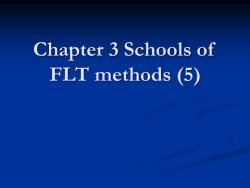
Chapter 3 Schools of FLT methods (5)
Chapter 3 Schools of FLT methods (5)

Task-Based Language Teaching 任务型语言教学 I.Second Language Acquisition and TBLT Ⅱ.What is TBLT Ⅲ.What Are Tasks? IV.Why do we use TBLT? V.Task Analysis VI.Planning Classroom Work VII.Principles of task design VI.Performance Assessment TBLT
Task-Based Language Teaching 任务型语言教学 Ⅰ. Second Language Acquisition and TBLT Ⅱ. What is TBLT Ⅲ. What Are Tasks? Ⅳ. Why do we use TBLT? Ⅴ. Task Analysis Ⅵ. Planning Classroom Work Ⅶ. Principles of task design Ⅷ. Performance Assessment & TBLT

I Second Language Acquisition Research ■“Practice makes perfect”does not always apply to learning grammar. They(students)often fail to use it correctly when expressing themselves freely.This temporary mastery seems to happen when they are paying conscious attention to form,but not when they are trying to communicate and paying attention to meaning. Jane Willis
Ⅰ. Second Language Acquisition Research ◼ “Practice makes perfect” does not always apply to learning grammar. ◼ They( students) often fail to use it correctly when expressing themselves freely. This temporary mastery seems to happen when they are paying conscious attention to form, but not when they are trying to communicate and paying attention to meaning. ◼ Jane Willis

根据语言习得的规律 1语法知识的记忆不能保证语言使用的正确 Knowledge of grammatical rules was no guarantee of being able to use those rules for communication.Learners who were able to identify instances of rule violation,and who could even state the rule,frequently violated the rules when using language for communication. David Nunan 1999
根据语言习得的规律 1. 语法知识的记忆不能保证语言使用的正确 ◼ Knowledge of grammatical rules was no guarantee of being able to use those rules for communication. Learners who were able to identify instances of rule violation, and who could even state the rule, frequently violated the rules when using language for communication. ◼ David Nunan (1999)
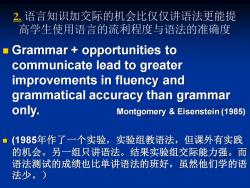
2.语言知识加交际的机会比仅仅讲语法更能提 高学生使用语言的流利程度与语法的准确度 Grammar opportunities to communicate lead to greater improvements in fluency and grammatical accuracy than grammar only. Montgomery Eisenstein(1985) ■(1985年作了一个实验,实验组教语法,但课外有实践 的机会。另一组只讲语法。结果实验组交际能力强。而 语法测试的成绩也比单讲语法的班好,虽然他们学的语 法少。)
2. 语言知识加交际的机会比仅仅讲语法更能提 高学生使用语言的流利程度与语法的准确度 ◼ Grammar + opportunities to communicate lead to greater improvements in fluency and grammatical accuracy than grammar only. Montgomery & Eisenstein (1985) ◼ (1985年作了一个实验,实验组教语法,但课外有实践 的机会。另一组只讲语法。结果实验组交际能力强。而 语法测试的成绩也比单讲语法的班好,虽然他们学的语 法少。)
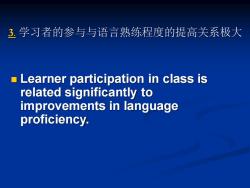
3.学习者的参与与语言熟练程度的提高关系极大 Learner participation in class is related significantly to improvements in language proficiency
3. 学习者的参与与语言熟练程度的提高关系极大 ◼ Learner participation in class is related significantly to improvements in language proficiency

4基本上以“交际”为导向的课堂教学,但同 时也有明确的语法讲解,要比只注重语法教学 或回避语法讲解的沉浸式教学都更好 Classrooms that were basically "communicative"for explicit grammatical instruction,were superior to both traditional classrooms that focused heavily on grammar,and to immersion programs that eschewed explicit grammatical instruction
4. 基本上以“交际”为导向的课堂教学,但同 时也有明确的语法讲解,要比只注重语法教学 或回避语法讲解的沉浸式教学都更好 ◼ Classrooms that were basically “communicative”for explicit grammatical instruction, were superior to both traditional classrooms that focused heavily on grammar, and to immersion programs that eschewed explicit grammatical instruction
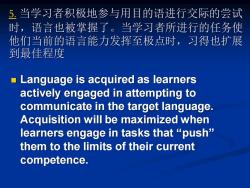
5当学习者积极地参与用目的语进行交际的尝试 时,语言也被掌握了。当学习者所进行的任务使 他们当前的语言能力发挥至极点时,习得也扩展 到最佳程度 Language is acquired as learners actively engaged in attempting to communicate in the target language. Acquisition will be maximized when learners engage in tasks that“push” them to the limits of their current competence
5. 当学习者积极地参与用目的语进行交际的尝试 时,语言也被掌握了。当学习者所进行的任务使 他们当前的语言能力发挥至极点时,习得也扩展 到最佳程度 ◼ Language is acquired as learners actively engaged in attempting to communicate in the target language. Acquisition will be maximized when learners engage in tasks that “push” them to the limits of their current competence
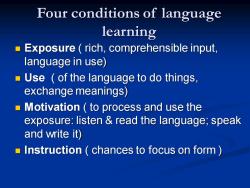
Four conditions of language learning ■ Exposure(rich,comprehensible input, language in use) Use of the language to do things, exchange meanings) Motivation to process and use the exposure:listen read the language;speak and write it) Instruction chances to focus on form
Four conditions of language learning ◼ Exposure ( rich, comprehensible input, language in use) ◼ Use ( of the language to do things, exchange meanings) ◼ Motivation ( to process and use the exposure: listen & read the language; speak and write it) ◼ Instruction ( chances to focus on form )

II.What is Task-Based Language Teaching ■Focuses on the construction, sequencing,and evaluation of particular goal-related 】action complexes that learners carry out either by themselves (see Prabhu's model 1987)or jointly (see Kumaravadivelu 1993) (Candlin Murphy 1987;Nunan 1989)
Ⅱ. What is Task-Based Language Teaching ◼ Focuses on the construction, sequencing, and evaluation of particular goal-related action complexes that learners carry out either by themselves (see Prabhu’s model 1987) or jointly (see Kumaravadivelu 1993) ◼ (Candlin & Murphy 1987; Nunan 1989)
按次数下载不扣除下载券;
注册用户24小时内重复下载只扣除一次;
顺序:VIP每日次数-->可用次数-->下载券;
- 《中学英语教学法》课程教学课件(PPT讲稿)Chapter 5 Schools of FLT methods(2/4).ppt
- 《中学英语教学法》课程教学课件(PPT讲稿)Chapter 8 Teaching strategies(Lead in strategies).ppt
- 《中学英语教学法》课程教学课件(PPT讲稿)Chapter 7 Microteaching skills(Reading).ppt
- 《中学英语教学法》课程教学课件(PPT讲稿)Chapter 9 Class observing strategies.ppt
- 《中学英语教学法》课程教学课件(PPT讲稿)Chapter 6 Contents of FLT(Vocabulary).ppt
- 《中学英语教学法》课程PPT讲稿(学科教学论)Chapter Three Introduction of learning theory(1/2).ppt
- 《中学英语教学法》课程PPT讲稿(学科教学论)Chapter five History of Foreign Language Teaching.ppt
- 《中学英语教学法》课程PPT讲稿(学科教学论)Chapter Four Introduction of SLA Theories(2/2).ppt
- 《中学英语教学法》课程PPT讲稿(学科教学论)Chapter Four Introduction of SLA Theories(1/2).ppt
- 《中学英语教学法》课程PPT讲稿(学科教学论)Chapter Six Introduction of Class Teaching Implementation.ppt
- 《中学英语教学法》课程PPT讲稿(学科教学论)Chapter seven Assessment.ppt
- 《中学英语教学法》课程PPT讲稿(学科教学论)Chapter eight Theories of Test(2/2).ppt
- 《中学英语教学法》课程PPT讲稿(学科教学论)Chapter eight Theories of Test(1/2).ppt
- 《中学英语教学法》课程PPT讲稿(学科教学论)Chapter nine Language Teachers in Classroom Teaching.ppt
- 《中学英语教学法》课程PPT讲稿(课堂教学策略)高中英语课堂观察与评价.ppt
- 《中学英语教学法》课程PPT讲稿(课堂教学策略)英语教师语言敏感意识提升与课堂教学——基于观课的反思.ppt
- 《中学英语教学法》课程PPT讲稿(课堂教学策略)如何开展培训需求分析.ppt
- 《中学英语教学法》课程PPT讲稿(课堂教学策略)树立正确的外语学习观是提高外语教学效率的关键.ppt
- 《中学英语教学法》课程PPT讲稿(课堂教学策略)英语老师行动研究 English Teachers inAction Research.ppt
- 《中学英语教学法》课程PPT讲稿(课堂教学策略)初中英语有效教学策略探讨.ppt
- 《中学英语教学法》课程教学课件(PPT讲稿)Chapter 5 Schools of FLT methods(3/4).ppt
- 《中学英语教学法》课程教学课件(PPT讲稿)Chapter 5 schools of FLT methods(1/4).ppt
- 《中学英语教学法》课程教学课件(PPT讲稿)Chapter 3 Teaching planning.ppt
- 《中学英语教学法》课程教学课件(PPT讲稿)Chapter 1 Instructional views in New Curriculum.ppt
- 《中学英语教学法》课程教学课件(PPT讲稿)Chapter 4 Teaching designing(Lesson planning).ppt
- 《中学英语教学法》课程教学课件(PPT讲稿)Chapter 2 Key issues in Foreign Language Teaching Methodology.ppt
- 《俄语语法》课程教学大纲 Russian grammar.doc
- 石河子大学:《俄语语法》课程教学资源(试卷习题)2013-2014俄语语法(二)期中答案.doc
- 石河子大学:《俄语语法》课程教学资源(试卷习题)2013-2014俄语语法(二)期中卷.doc
- 石河子大学:《俄语语法》课程教学资源(试卷习题)语法二期末试卷及答案_2013-2014(2)俄语语法(二)A答案.doc
- 石河子大学:《俄语语法》课程教学资源(试卷习题)语法二期末试卷及答案_2013-2014(2)俄语语法(二)A卷.doc
- 石河子大学:《俄语语法》课程教学资源(试卷习题)语法四期末试卷及答案_2013-2014(2)俄语语法(四)A答案.doc
- 石河子大学:《俄语语法》课程教学资源(试卷习题)语法四期末试卷及答案_2013-2014(2)俄语语法(四)B答案.doc
- 石河子大学:《俄语语法》课程教学资源(试卷习题)语法四期末试卷及答案_2013-2014(2)俄语语法(四)A卷.doc
- 石河子大学:《俄语语法》课程教学资源(试卷习题)语法四期末试卷及答案_2013-2014(2)俄语语法(四)B卷.doc
- 《俄语语法》课程教学资源(配课练习,无答案)人名.doc
- 《俄语语法》课程教学资源(配课练习,无答案)时间前置词(1/2).doc
- 《俄语语法》课程教学资源(配课练习,无答案)形容词(1/3).doc
- 《俄语语法》课程教学资源(配课练习,无答案)时间前置词(2/2).doc
- 《俄语语法》课程教学资源(配课练习,无答案)形容词(2/3).doc
